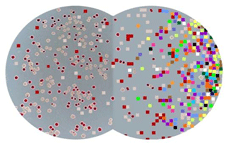Research Interests
Main focus
The main focus of my lab is on experimental evolution. Evolution is usually investigated using the comparative method or by studying fossils. Our approach is to watch evolution as it happens, in the context of experiments that are replicated and performed under controlled conditions. The idea of watching evolution in action is not new. In fact, Charles Darwin, in the first edition of On the Origin of Species (1859, p. 187), said "In looking for the gradations by which an organ in any species has been perfected, we ought to look exclusively to its lineal ancestors ; but this is scarcely ever possible, and we are forced in each case to look to species of the same group, that is to the collateral descendants from the same original parent-form."
In order to study evolution as it happens requires either a time machine (which we don't have) or else organisms that replicate, mutate, and evolve very fast, so that we can detect changes on a reasonable time scale. In our research, we are now performing experiments with two different fast-evolving systems:
- Bacteria, primarily Escherichia coli; and
- Digital organisms in the Avida system.
In both systems, we are investigating the dynamics of evolution, including genomic as well as phenotypic changes. We aim to integrate our understanding of these genomic and phenotypic changes by identifying and manipulating the genetic and ecological determinants of organismal performance and fitness. The approaches we use to draw these connections span a wide range, from finding specific mutations of interest to analyzing arrays that summarize the relationship between the entire genome and all the phenotypes that it encodes. By using two very different systems, we seek commonalities that may indicate more general features of evolving systems. Of equal interest, major differences between these systems may lead us to further experiments that explore the reasons for particular outcomes.
Long-Term Evolution Experiment
In a long-term evolution experiment with E. coli, we founded 12 replicate populations from the same ancestor, and these populations have evolved for more than 30,000 generations in identical environments. We have performed competition experiments to quantify changes in organismal fitness, analyzed whole-genome expression arrays to find beneficial mutations in genes encoding global regulators, and measured spontaneous mutation rates to discover changes in DNA-repair functions - among many other approaches and findings. Even after more than a decade of study, we continue to find fascinating evolutionary changes in these evolving populations.
Digital Work
My work on digital organisms started only a few years, when I began collaborating with Chris Adami (Caltech) and Charles Ofria (now at MSU) on experiments using their Avida software. Digital organisms are computer programs that self-replicate, mutate, compete, adapt and evolve in the computational world in which they live. The Avida system builds on Tierra, which was developed by the ALife pioneer Tom Ray, with a number of differences and extensions. A key feature of Avida is that digital organisms can evolve not only to become faster replicators, but they may obtain more resources that accelerate their replication by performing logic functions. In addition to looking for commonalities and differences with bacterial evolution, Avida allows us to probe more deeply than one could ever achieve even with a magnificent living system like E. coli. For example, we recently published in Nature a study showing the de novo origin of a complex organismal function, in which we could trace every one of the dozens of mutations that led up to the appearance that function. Moreover, we could see how each of these mutations affected all other phenotypic properties of the digital organisms. And we could do this for tens of replicate populations in many different selective environments.
Bacteria, Viruses and Plasmids
In other current and past projects, we have used bacteria, and the viruses and plasmids that infect them, to study:
- Connflict and cooperation in social bacteria
- Adaptation to variable environments
- Form and extent of interactions among mutations
- Evolution and control of mutation rates
- Ecology and evolution of host-parasite interactions
- Evolution of antibiotic resistance
